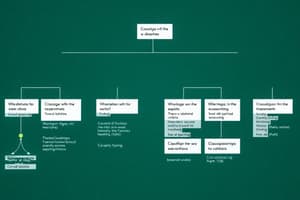Podcast
Questions and Answers
What effect does pruning a regression tree have on the number of leaves?
What effect does pruning a regression tree have on the number of leaves?
- The number of leaves increases significantly
- The number of leaves is unaffected by pruning
- The number of leaves decreases significantly (correct)
- The number of leaves remains unchanged
What is the main idea behind bagging and random forest?
What is the main idea behind bagging and random forest?
- To fit a single complex tree to the data
- To prune trees to reduce complexity
- To calculate predictor importance
- To fit many weak trees to limit overfitting and improve performance (correct)
What is the main difference between bagging and random forest?
What is the main difference between bagging and random forest?
- The number of trees fitted
- The complexity of the trees
- The number of features used for selection at each split (correct)
- The type of data used
What happens to the performance of a model when using bagging and random forest compared to a single deeper tree?
What happens to the performance of a model when using bagging and random forest compared to a single deeper tree?
What can be calculated after pruning a regression tree?
What can be calculated after pruning a regression tree?
What is the purpose of cross-validation in regression trees?
What is the purpose of cross-validation in regression trees?
What is cost complexity pruning in regression trees?
What is cost complexity pruning in regression trees?
How long does the pruning process take according to the text?
How long does the pruning process take according to the text?
What is the purpose of pruning a decision tree in machine learning?
What is the purpose of pruning a decision tree in machine learning?
What is the benefit of cross-validation in machine learning?
What is the benefit of cross-validation in machine learning?
What is the output of the cost-complexity pruning path in decision trees?
What is the output of the cost-complexity pruning path in decision trees?
What is the purpose of calculating metrics for all folds in cross-validation?
What is the purpose of calculating metrics for all folds in cross-validation?
What is the difference between the accuracy calculated with cross-validation and with a validation set?
What is the difference between the accuracy calculated with cross-validation and with a validation set?
What is the idea behind tree pruning in decision trees?
What is the idea behind tree pruning in decision trees?
Why is max_depth not set as a limit for the tree's complexity in the pruning process?
Why is max_depth not set as a limit for the tree's complexity in the pruning process?
What is the purpose of applying cost-complexity pruning to a decision tree?
What is the purpose of applying cost-complexity pruning to a decision tree?
What is the criterion used in regression trees?
What is the criterion used in regression trees?
How is the predictor importance calculated in regression trees?
How is the predictor importance calculated in regression trees?
What is the purpose of cross-validation in regression trees?
What is the purpose of cross-validation in regression trees?
What is the first step in pruning a regression tree?
What is the first step in pruning a regression tree?
What is the next step after getting the alphas in cost complexity pruning?
What is the next step after getting the alphas in cost complexity pruning?
What is the purpose of pruning a regression tree?
What is the purpose of pruning a regression tree?
What is the output of the cross-validation step in regression trees?
What is the output of the cross-validation step in regression trees?
What is the importance of using the same tree configurations in cross-validation?
What is the importance of using the same tree configurations in cross-validation?
Study Notes
User-Defined Functions
- Classification trees use cross-validation to calculate the cross-validated error, and the metrics are calculated for all folds, then averaged.
Tree Pruning
- Tree pruning involves growing a deep tree and then pruning it to improve its performance.
- The unpruned tree's metrics are calculated to compare before and after pruning.
- Cost-complexity pruning is applied to the tree, resulting in a Python dictionary object including the α values and their corresponding impurity measures.
Regression Trees
- Regression trees are used in a regression setting, and the Concrete data is used.
- The criterion used is 'squared_error', and other possible arguments can be accessed through online documentation.
- Predictor importance is calculated and plotted based on the variance explanation due to splits of the tree.
Regression Trees - Cross Validation
- Cross-validation is used to get the cross-validated test error, similar to the classification setting.
- The same tree configurations (max_depth,…) should be used to compare the validation set error with the cross-validated error.
Regression Trees - Pruning
- Pruning involves growing a deep tree with no restrictions for the depth, resulting in a large number of leaves.
- Cost-complexity pruning is applied, involving getting the alphas and then doing an exhaustive search.
Bagging and Random Forest
- The main idea of bagging and random forest is to fit many weak trees to limit overfitting and improve performance.
- The main difference between bagging and random forest is the number of features (predictors) used for selection at each split.
- In bagging, all features are selected, while in random forest, the selection is limited.
- The max_features is set as the number of columns in the predictors' data frame.
- Bagging and random forest show a significant improvement in performance compared to a single deeper tree.
- Predictors' importance can be calculated and plotted.
Studying That Suits You
Use AI to generate personalized quizzes and flashcards to suit your learning preferences.
Description
This quiz covers classification trees and cross-validation in machine learning, specifically for industrial engineering applications. It assesses understanding of model assessment metrics and user-defined functions




